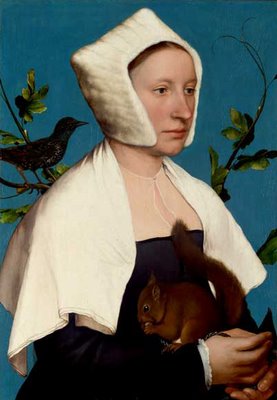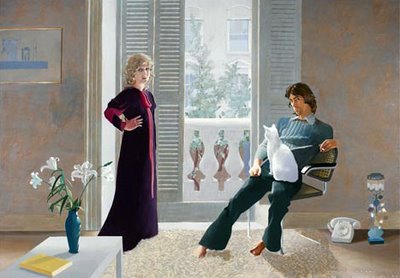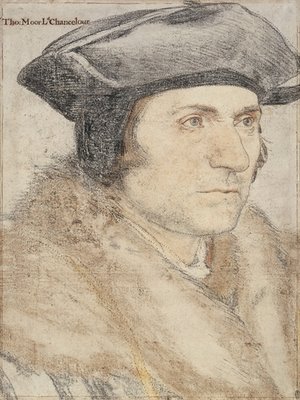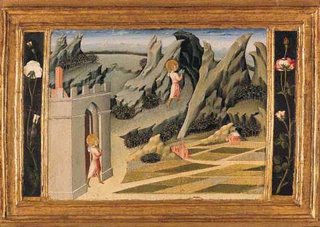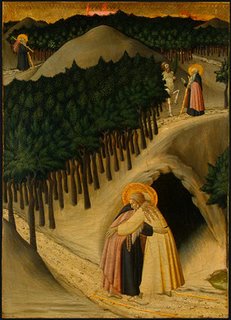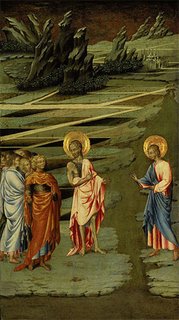Donald Trump
and Andy Warhol, 1983. Photo by Mario Suriani.
I stumbled upon the above
photograph during some recent internet ramblings, and laughed: the “Don”, a
horse, and Andy Warhol – that’s funny. But upon further thought, and considering
the current state of things, I was confused. Why was Donald Trump palling
around with Warhol in the 80s? In the photograph, they both display an easy
demeanor and the hint of a smile, despite the fact that they are separated by a
race horse(?). What’s the story here? Were they friends? What does Trump think
about art?
The image sparked my
curiosity, and gave me pause for thought. As Cleveland recently undertook a major sprucing
up for the RNC (a complete house-cleaning including a flurry of publicly funded
artistic activities[1]), it
is perhaps the perfect time to take measure of the Republican party’s position on
the arts, and further, what, if any, arts policies would Mr. Trump advocate?
“Cleveland
is a city of arts, culture and rock and roll,” reads the first sentence
on the RNC
website’s “About Cleveland” tab. A promising description, but then one has to scroll down
through seven subheadings (Lake Erie, Golf, Parks & Outdoors, Music,
Casinos & Racetracks, Sports, and Dining) before you reach “Arts &
Culture”. The “Plan Your Trip” Section is a bit more promising, offering links
to “Cleveland’s Public Art Scene” and several museums. But beyond fun activities while you’re in
town for the convention, the Republican Party’s official stance on arts funding
is difficult to discern. Taking a look
at their official 2016 platform is no help – the issue seems to be off
the national radar these days.
Trump’s own
policies on the arts are similarly laconic, bordering on the non-existent. Good luck even finding the word “art” on his own
website, other than in
the title of his most famous book, The
Art of the Deal. Digging a bit deeper, I did find a profile for the
candidate on the Americans for the Arts Action Fund website, as well as his answers to a list of
arts-related questions posed by blogger and Washington Post writer Alyssa
Rosenberg back in March. She sent a list
of thirteen questions to all the candidates, and surprisingly she only heard back from Trump (Bernie, who often referred to himself
as the future “arts president” failed to respond).
Unfortunately, Trump did not answer all the questions, and he mostly
deferred his answers to the actions of Congress or the States. For a
man known for being downright bellicose, Trump is unusually reticent when it
comes to the arts. And since Trump has no political record, one is forced to go
to his business and personal history to find examples of his attitudes about
art. And if these precedents are any
indication of his future intentions, it doesn’t bode well.
Writing for ARTnews in April of this year, M.H. Miller perhaps summed up Trump’s relationship
to the arts perfectly: “Trump’s name—not to mention his physical presence—is an
unfamiliar sight in the city’s major cultural institutions. Wealthy
public figures often fall into cultural patronage if for nothing else than the
tax break. But since the beginning of his career, Trump has been, at
best, apathetic to the arts in New York, and elsewhere.” But there are some famous anecdotes such as
the time he mistook a Donald Judd sculpture at MOMA for a
table(?), and carelessly tossed his
coat and some binders onto it. Or there
was the time he told a reporter that the Renoir signature on a
painting on his private jet was worth 10 million, despite the fact that all of the paintings in his
personal collection are known to be reproductions, including another often
referenced Renoir that once hung in Ivana’s office (the original 1874 painting La loge is
in the Courtauld Gallery, London). And one of the only mentions of an authentic
work of art owned by Trump are some sixteenth-century Flemish tapestries in his
Florida home, that have been badly
damaged by Trump’s negligence and the Florida sun according to his butler.
But anecdote aside, let’s
get back to Warhol – what was going on in that photograph? According to an excellent blog post on the Warhol
Museum site, the two met at a
birthday party for the famous attorney Ray Cohn in 1981, and apparently got
along well enough for Trump to visit the Factory soon after. Their friendship seemingly blossoming, Trump
asked Warhol to paint a “portrait” of a new building he was about to build, to
be called “Trump Tower”. The plan was
for Warhol to make a large painting of the building that would grace the
entrance lobby of the magnificent structure.
After visiting the construction site, taking photos, and looking at
architectural models, Warhol burned drawings based on the photos and models
onto separate silkscreens. As the author
of this post explains, “the result was a beautiful series of multilayered
paintings in black, silver, and gold; some with a sprinkling of Warhol’s
glittering diamond dust.”
Andy Warhol, Trump Tower,
both 1981, Warhol Museum. Will Trump’s
presidential campaign result in a new level of importance for these paintings?
The commission did not end
well, however. When Trump returned to
the Factory, he was unhappy with the artist’s efforts, as Warhol relates in his
diary:
“The Trumps came down.
[…] I showed them the paintings of the Trump Tower that I’d done. I don’t know
why I did so many, I did eight. In black and grey and silver which I thought
would be so chic for the lobby. But it was a mistake to do so many, I think it
confused them. Mr. Trump was very upset that it wasn’t color-coordinated. They
have Angelo Donghia [a famous interior designer] doing the decorating so
they’re going to come down with swatches of material so I can do the paintings
to match the pinks and oranges. I think Trump’s sort of cheap, though, I get
that feeling.” via The
Warhol: Blog.
Trump
never returned, and he never paid for the paintings. Perhaps they were too dark, too ominous for
someone expecting them to match a pink and orange color scheme. Warhol often expressed resentment towards the
Trumps in his diaries after the incident.
Two of the paintings ended up in the collection of the Warhol Museum in
Pittsburgh, and the others are scattered in collections around the world.
In
a striking bit of irony, to make room for Trump Tower of the corner of Fifth
Avenue and E. 56th Street, the Bonwit Teller Department Store was
torn down – a fact that Warhol surprisingly does not mention in his
diaries. Warhol worked there for nearly
twenty years, where he created many of the store’s massive window displays –his
most famous was installed in April 1961, and included some of his very first
experiments in what would become “Pop Art”.
In fact Bonwit Teller featured the work of many famous artists in their Fifth Avenue storefront windows including James Rosenquist, Robert Rauschenberg,
Jasper Johns, and Salvador Dali.
As Trump’s crews began to
dismantle the historic building, in a seemingly benevolent move, he promised to
give the two 15 foot-tall decorative panels high on the building’s exterior of
to the Metropolitan Museum of Art. Excellent
examples of the Art Deco style, the panels were original to the 1929 building,
and showed stylized female figures. He
had also promised to save a piece of rare bronze grillwork at the building’s
entrance, but sadly neither survived – as the NY Times reported on June 6,
1980: “Two stone
bas-relief sculptures high on the façade of the Bonwit Teller Building under
demolition on Fifth Avenue – pieces that had been sought with enthusiasm
by the Metropolitan Museum of Art – were smashed by jackhammers yesterday
on the orders of a real estate developer.” The unnamed ‘developer’ was Trump, who at the time was not yet a well-known figure,
but would become no stranger to the kind of media frenzy that followed this
controversial incident.
Perhaps having learned his
lesson early from Sculpture-Gate, it does not seem that Trump has bulldozed
anything of artistic importance since.
In fact, one of his most recent projects demonstrates that Trump can occasionally
see the value in renovating a historic structure. Slated to open in September of this year,
Trump has transformed the Old Post Office on Pennsylvania Avenue in Washington
D.C. into a 270-room luxury hotel. In a 2014 press release Trump boasted: “We
will work to restore this magnificent building to even well beyond its original
grandeur” – and indeed photographs on the Trump Hotels website show that some care was taken in restoring this
landmark building.[2] The hotel is already offering specials for
the January 2017 Inauguration, and boasts one of the largest ballroom spaces in
the city – this is the kind of timing that could not be coincidental (a sign
outside the building reads: Coming 2016 / TRUMP, meaning the hotel, obviously).
Image
via Buzzfeed.
Unfortunately, the previous
occupants of the historic building were forced to vacate the premises – tenants
that included the National Endowment for the Arts (NEA), the National Endowment
for the Humanities (NEH), the President’s Committee
on the Arts and Humanities (PCAH), and other federal agencies related to the
arts. But I’m sure that was just coincidental, right?
[1]
Including the Public Square Redesign, ROCK BOX, #flockCLE, Inter|Urban Art & Culture Connector, among many other projects.
[2]
However, an investigative article on Buzzfeed outlines many allegedly disturbing decisions
concerning the renovations, and regarding the apparently shady purchase of the
taxpayer-owned structure.












